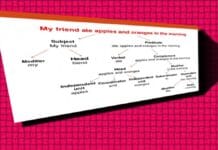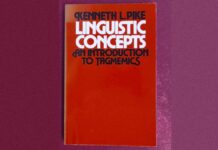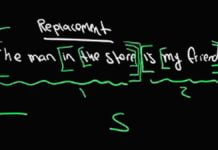The tagmemic theory is concerned primarily with a grammatical analysis and is especially associated with Kenneth Lee Pike. It is an offshoot of structuralism. Structuralism ignored the functions of a linguistic form and concentrated only on form. Tagmemics fuses the form as well as the function of a linguistic entity. According to this approach, utterances can be analyzed simultaneously at three interpenetrating levels, where each level represents a hierarchy of units. These levels are lexical (with the minimum unit being morpheme), phonological (having phoneme as the minimum unit), and grammatical (in which the minimum unit is tagmeme).
The grammatical component is a series of syntactic statements concerning sentence, clause, phrase, and word-level structures. The lexicon lists the formal unit of language while phonological components give the phonemic sentence a phonetic realization in the language. Pike rejected the idea of a sentence as being the minimum unit of grammar and recommended a hierarchical order and labelling. It has three semi-autonomous but interlocking levels or modes -phonology, grammar and lexicon. It stresses the hierarchical ordering of grammatical units into ranks of levels -morphemes, words, phrases, clauses, sentences, paragraphs, and discourses.
A tagmeme is the smallest functional element in the grammatical structure of a language. The term was introduced in the 1930s by the linguist Leonard Bloomfield, who defined it as the smallest meaningful unit of grammatical form, analogous to the morpheme, defined as the smallest meaningful unit of lexical form. The term was later adopted, and its meaning broadened, by Kenneth Pike and others beginning in the 1950s, as the basis for their tagmemics.
The tagmeme is the correlation of a syntagmatic function (E.g., subject, object) and paradigmatic fillers (E.g., nouns, pronouns or proper nouns as possible fillers of the subject position). Tagmemes combine to form a syntagmeme, a syntactic construction consisting of a sequence of tagmemes. Tagmemics makes the kind of distinction made between phone and phoneme in phonology and phonetics at higher levels of linguistic analysis (grammatical and semantic); for instance, contextually conditioned synonyms are considered different instances of a single tagmeme, as sounds which are (in a given language) contextually conditioned are allophones of a single phoneme. The emic and etic distinction also applies in other social sciences.
A tagmeme is defined as “the correlation of the grammatical function or slot with a class of mutually substitutable items occurring in that slot.” In other words, it is the relation between function and category. The subject position filled by a Noun phrase, the predicate filled by a verb, etc, are examples of tagmemes.
E.g., She saw John.
This sentence has 3 tagmemes.
Subject + verbal + object
pronoun transitive verb noun
Here, the subject, verbal, and object slots are filled by a pronoun, a transitive verb and a noun respectively. The formula for such a sentence = SVO.
In tagmemics, a construction is a string of tagmeme units. These constructions can exist at various levels — E.g., the morpheme, the word, the phrase, the sentence, and so on. The tagmemic analysis given above (She saw John) belongs to the sentence level. An example of tagmemic analysis at the syllable level is presented below:
Tagmemic units = b e g in the word beg.
tagmeme1 tagmeme 2 tagmeme 3
non syllabic slot + syllabic slot + non syllabic slot
b e g
Immediate Constituent analysis of the structuralists insists just on binary cuts, but tagmemics always goes in favour of string constituent analysis, and have many cuts. Tagmemics, unlike a structural analysis, asks for the function of the categories and not merely their naming. It is a “slot and filler grammar”; a slot being a position in the construction frame. The filler class is the co-relation between a grammatical function like a subject and a class of fillers like nouns that can fill that function. But neither the slot nor the filler itself is important, it is the tagmeme which is significant. The slot is the function and the filler is the category. A tagmeme, therefore, is the co-relation of a slot and the class of items that can occur in that slot. Hence we have sentence-level tagmemes, clause-level tagmemes, phrase-level tagmemes, word-level tagmemes and morpheme-level tagmemes.
For example, The boy ate all his candy yesterday has the following tagmemes:
Base — transitive clause + intonation tagmeme
T — cl Int: F
Clause level tagmeme
S: NP + Pr: tv + O: n+ Tense: past
Phrase level tagmeme
Det: det + H: n
Word level tagmeme
ate — Nuc: Verb stem + Tense: past
Morpheme level Tagmeme
Eat
The + and + signs are important in tagmemic formulae; in a generalized formula + precedes obligatory component tagmeme and + precedes optional component tagmeme. In the same way, as mentioned above, the sentence: “He likes books” consists of three tagmemes -the subject' slot filled by a pronoun, thepredicate’ slot filled by the transitive verb, and the `object’ slot filled by a noun. Formulatically, it can be represented as
S: pn + P: tv + O: n
In bringing together into one unit, the tagmeme, of a grammatical function and a formal class seem especially valuable in the analysis of languages where a variety of formally different elements in English nouns and pronouns can function both as subjects and objects.
In this connection, one of the fundamental aims of tagmemic theory has been stated by Longacre: “Tagmemics is a reaffirmation of function in a structuralist context.
Tagmemics has been the most fertile as far as the description of exotic languages is considered. Several Red Indian and African languages have been described on the tagmemic model. It seems that this model is particularly convenient in describing languages that have not been studied before.






























